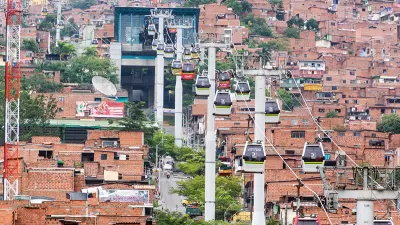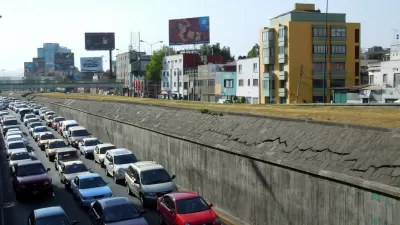Unlike many aerial gondolas, Mexico City’s Cablebus is largely used by commuters and residents from communities farther from the city center.

A three-year-old aerial cable car system is transforming Mexico City’s transportation network and making the trip into the central city faster and easier for people living in peripheral neighborhoods.
As Alex Vasquez explains in Bloomberg CityLab, “The Cablebus system has more than halved trips that used to take an hour and a half by bus or taxi, according to Mexico City's Mobility Ministry. In the sprawling megacity of some 22 million people, faster connections were needed for residents living far from the center and the major subway lines.”
Unlike many other aerial tram systems around the world, Mexico City’s system primarily serves residents in far-flung neighborhoods rather than tourists, “Most of the systems, like the ones in Medellin or in Caracas, Venezuela, move between 15,000 and 40,000 people a day; the Cablebus moves between 70,000 and 80,000 people a day.”
Residents perceive the Cablebus as safer than the city’s other transit options such as the subway system, where the city has created women-only cars to create safer spaces for women travelers, “Gisela Mendez, founder of urban development consultancy Ensamble Urbano, said that situations of harassment and violence against women are considerably reduced on the Cablebus compared to other transport systems.” For people whose work gives them less traditional schedules, the Cablebus’s round-the-clock schedule is also more convenient than buses or trains, whose services are concentrated around typical rush hours.
FULL STORY: The Cablebus Transformed Commutes in Mexico City’s Populous Outskirts

Alabama: Trump Terminates Settlements for Black Communities Harmed By Raw Sewage
Trump deemed the landmark civil rights agreement “illegal DEI and environmental justice policy.”

Study: Maui’s Plan to Convert Vacation Rentals to Long-Term Housing Could Cause Nearly $1 Billion Economic Loss
The plan would reduce visitor accommodation by 25% resulting in 1,900 jobs lost.

Planetizen Federal Action Tracker
A weekly monitor of how Trump’s orders and actions are impacting planners and planning in America.

Wind Energy on the Rise Despite Federal Policy Reversal
The Trump administration is revoking federal support for renewable energy, but demand for new projects continues unabated.

Passengers Flock to Caltrain After Electrification
The new electric trains are running faster and more reliably, leading to strong ridership growth on the Bay Area rail system.

Texas Churches Rally Behind ‘Yes in God’s Back Yard’ Legislation
Religious leaders want the state to reduce zoning regulations to streamline leasing church-owned land to housing developers.
Urban Design for Planners 1: Software Tools
This six-course series explores essential urban design concepts using open source software and equips planners with the tools they need to participate fully in the urban design process.
Planning for Universal Design
Learn the tools for implementing Universal Design in planning regulations.
Caltrans
Smith Gee Studio
Institute for Housing and Urban Development Studies (IHS)
City of Grandview
Harvard GSD Executive Education
Toledo-Lucas County Plan Commissions
Salt Lake City
NYU Wagner Graduate School of Public Service





























